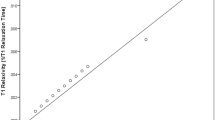Abstract
By the spleen, we calculated a time-delay correction of the input function for quantitation of hepatic blood flow with oxygen-15 water and dynamic positron emission tomography. The time delay (Δt) between the sample site and the spleen was calculated based on nonlinear multiple regression analysis when splenic blood flow was determined. Then hepatic blood flow was quantified by a method using the input function and incorporating Δt, which was assumed to be equal to the time delay between the sample site and the liver. Then hepatic arterial and portal blood flows were estimated separately as well as the delay time for passage within the organs of the portal circulation. The mean coefficient of variation and the mean sum of squares of errors decreased to about 70% when total hepatic blood flow was calculated from the results for regions of interest in three slices of the same liver segment. We concluded that using the spleen for time-delay correction of the input function for measuring hepatic blood flow by this method gave satisfactory results.
Similar content being viewed by others
References
Iida H, Higano S, Tomura N, Shishido F, Kanno I, Miura S, et al. Evaluation of regional differences of tracer appearance time in cerebral tissues using [15O] water and dynamic positron emission tomography.J Cereb Blood Flow Metab 8: 285–288, 1988.
Meyer E. Simultaneous correction for tracer arrival delay and dispersion in CBF measurements by the H2 15O autoradiographic method and dynamic PET.J Nucl Med 30: 1069–1078, 1989.
van den Hoff J, Burchert W, Müller-Schauenburg W, Meyer GJ, Hundeshagen H. Accurate local blood flow measurements with dynamic PET: Fast determination of input function delay and dispersion by multilinear minimization.J Nucl Med 34: 1770–1777, 1993.
Taniguchi H, Oguro A, Takeuchi K, Miyata K, Takahashi T, Inaba T, et al. Difference in regional hepatic blood flow in liver segments—Non-invasive measurement of regional hepatic arterial and portal blood flow in human by positron emission tomography with H2 15O—.Ann Nucl Med 7: 141–145, 1993.
Taniguchi H, Oguro A, Koyama H, Masuyama M, Takahashi T. Analysis of models for quantification of arterial and portal blood flows in the human liver using positron emission tomography.J Comput Assist Tomogr 20: 135–144, 1996.
Taniguchi H, Oguro A, Koyama H, Miyata K, Takeuchi K, Takahashi T. Determination of spleen-blood partition coefficient for water with oxygen-15-water and oxygen-15-carbon dioxide dynamic PET steady state method.J Nucl Med 36: 599–602, 1995.
Taniguchi H, Koyama H, Masuyama M, Takada A, Mugitani T, Tanaha H, et al. Angiotensin II-induced hypertension chemotherapy: Evaluation of hepatic blood flow with 15-Oxygen PET.J Nucl Med 37: 1522–1523, 1996.
Huchzermeyer H, Schmitz-Feuerhake I, Reblin T. Determination of splenic blood flow by inhalation of radioactive rare gases.Eur J Clin Invest 7: 345–349, 1977.
Peters AM, Klonizakis I, Lavender JP, Lewis SM. Use of111Indium-labelled platelets to measure spleen function.Br J Haematology 46: 587–593, 1980.
Manoharan A, Gill RW, Griffiths KA. Splenic blood flow measurements by Doppler ultrasound.Cardiovascular Res 21: 779–782, 1987.
Iida H, Kanno I, Miura S, Murakami M, Takahashi K, Uemura K. Error analysis of a quantitative cerebral blood flow measurement using H2 15O autoradiography and positron emission tomography, with respect to dispersion of input function.J Cereb Blood Flow Metab 6: 536–545, 1986.
Yasuhara Y, Miyauchi S, Hamamoto K. A measurement of regional portal blood flow with Xe-133 and balloon catheter in man.Eur J Nucl Med 15: 245–250, 1989.
Shiomi S, Kuroki T, Ueda N, et al. Measurement of hepatic blood flow by use of perirectal portal scintigraphy with133Xe.Nucl Med Commun 12: 235–242, 1991.
Ziegler SI, Haberkorn U, Byrne H, Tong C, Kaja S, Richolt JA, et al. Measurement of liver blood flow using oxygen-15 labeled water and dynamic positron emission tomography: limitations of model description.Eur J Nucl Med 23: 169–177, 1996.
Fleming JS, Ackery DM, Walmsley BH, Karran SJ. Scintigraphic estimation of arterial and portal blood supplies to the liver.J Nucl Med 24: 1108–1113, 1983.
Author information
Authors and Affiliations
Corresponding author
Rights and permissions
About this article
Cite this article
Taniguchi, H., Yamaguchi, A., Kunishima, S. et al. Using the spleen for time-delay correction of the input function in measuring hepatic blood flow with oxygen-15 water by dynamic PET. Ann Nucl Med 13, 215–221 (1999). https://doi.org/10.1007/BF03164895
Received:
Accepted:
Issue Date:
DOI: https://doi.org/10.1007/BF03164895




